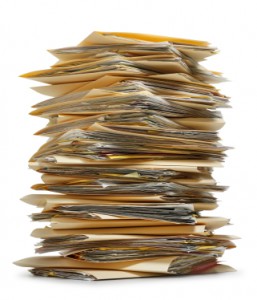 While my article about arranging your family papers in the winter edition of American Ancestors was meant to provide readers with the sense that they could preserve their collections on their own, I thought it would be helpful to go back and provide information that had to be removed from earlier drafts, beginning with defining some of the archival terms that I used.
While my article about arranging your family papers in the winter edition of American Ancestors was meant to provide readers with the sense that they could preserve their collections on their own, I thought it would be helpful to go back and provide information that had to be removed from earlier drafts, beginning with defining some of the archival terms that I used.
The first word that I use is “record/s.” As genealogists, we are used to identifying a record by the purpose for which it was created, such as vital records or census records. The Society of American Archivists (SAA) lists multiple definitions of what an archival record is, but the basic definition that applies to family papers is: Data or information in a fixed form that is created or received in the course of individual or institutional activity and set aside (preserved) as evidence of that activity for future reference. Even if something is considered a record, it is OK to remove copies from your collection if there are extras that do not add “value” to the overall collection. For example, if you have multiple copies of newspaper clippings, without annotations, you could remove the extra copies.
When talking about archival collections, the creator is the person or group who created the group of records and used them…
The second definition that I felt should be included was “creator.” When talking about archival collections, the creator is the person or group who created the group of records and used them, not the person who created the individual items. If you were to arrange your great-grandmother’s correspondence, the material would not be separated into individual collections based on the authors because they were not the people who accumulated and used the letters. (You could use the authors of the letters to create the series, though.)
The name of the creator or creators play an important role in giving a collection its name, and if you wanted to give your collection a title that conforms to the SAA standard then you should examine section 2.3 of Describing Archives: A Content Standard, Second Edition, with particular attention to sections 2.3.10 through 2.3.15 for family papers.
The last archival term that I wanted to define was “series.” The SAA defines that term as A group of similar records that are arranged according to a filing system and that are related as the result of being created, received, or used in the same activity; a file group; a record series. The Bacon family papers I mentioned in my article contained many documents from a small group of family members and warranted the creation of additional series (known as sub-series) to describe each family member’s records. But that is not always the case: I recently worked on a family archive package that had material created by many different family members, but I did not need to create sub-series because they might have contained just one item.
In my next blog post, I will go into more detail on how I begin organizing a collection and elaborate on creating series and sub-series for your collection.
Continued here.
I appreciate all the help. I have documents and photos from the previous three generations of Monroe’s who came west. It is a daunting task.
After many false starts, I now do family group sheets for each family in my direct line and store them, along with any other documentary materials, clippings, and photos, on my computer in files for each direct line couple in each generation, with subfolders under the appropriate couple for adult children not in my direct line. I also have stored a series of 5 generation charts of my direct line to give a snapshot view. These files are backed up with every change to an external hard drive, and with every few changes to 2 flash drives. Printed copies and original photos are stored in archival folders in archival boxes by famil group and main ancestral lines. Once a year I send a copy of everything I have done to date on a flash drive to my siblings and my children for their records. This way I hope that the work will be kept by someone in the family after I am gone or sent off to one or more genealogical societies for more permanent safekeeping.